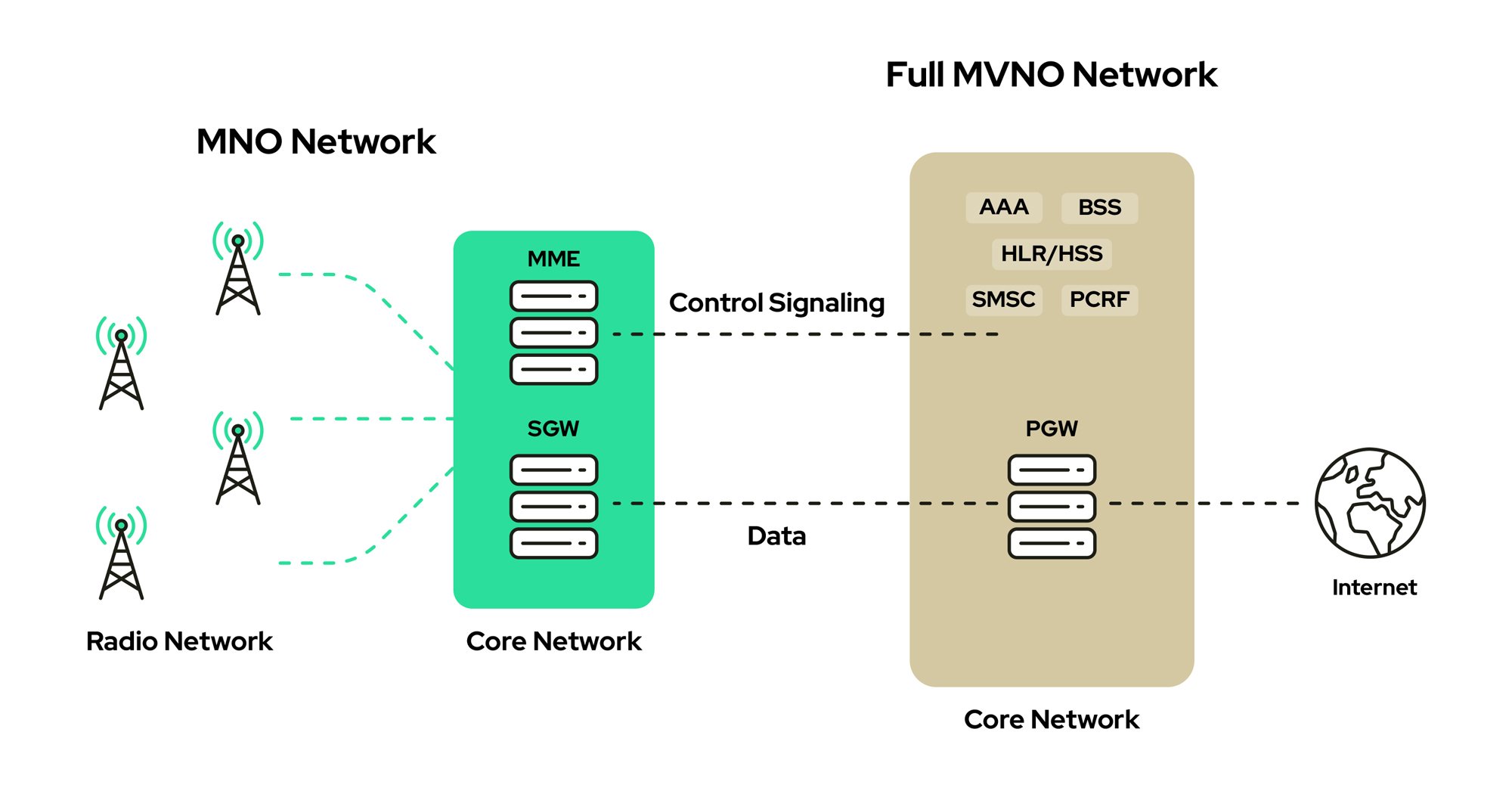This allows them to offer the same coverage as traditional carriers, but with greater freedom to innovate and focus on customer needs.
In simple terms, MVNOs do not build cell towers or maintain physical infrastructure. Instead, they buy access to those networks and concentrate on creating better services, pricing models, and customer experiences. For businesses, this means more flexibility and more specialized solutions.
Table of contents
How MVNOs work
The strengths of MVNOs
Different types of MVNOs
The advantages of MVNOs
Why MVNOs are perfect for IoT
Com4: the MVNO built for IoT
Elevate your IoT connectivity with Com4
How MVNOs work
MVNOs purchase network capacity at wholesale rates and then create service plans that meet the needs of their customers. By not running their own networks, they avoid huge infrastructure costs. This frees them to invest in areas that make a difference to customers: better support, smarter connectivity options, and plans that can be adapted as business requirements change.
Think of it this way: MNOs provide the “roads” for connectivity, while MVNOs design the “vehicles” and “routes” that make the journey smoother, faster, and more efficient.
The strengths of MVNOs
The structure of an MVNO is built around customer value:
- Network access ensures that businesses enjoy reliable coverage worldwide through strong agreements with leading MNOs.
- Core network capabilities allow MVNOs to manage services more flexibly, tailoring them to specific business requirements.
- Customer service is more personal and responsive than what large MNOs typically provide. MVNOs are known for solving issues quickly and building closer relationships with their customers.
- SIM and eSIM management streamlines the process of connecting devices, tracking usage, and handling billing. This makes it easy for businesses to manage even large-scale IoT deployments.
Different types of MVNOs
MVNOs are diverse and can be designed for different needs. Discount MVNOs focus on affordability, while premium MVNOs emphasize high-quality services and advanced features. Niche MVNOs serve specific groups, such as international travelers or businesses with tailored IoT requirements. Data-only MVNOs provide connectivity for devices and users who rely mainly on internet access.
These categories highlight the flexibility of the MVNO model. No matter the segment, there is usually an MVNO solution that fits.
The advantages of MVNOs
MVNOs deliver clear benefits compared to traditional carriers. Because they avoid the cost of running infrastructure, their services are often more affordable. Their flexibility makes it easy for customers to scale up or down depending on their needs, and their ability to customize services means that each business can get exactly the connectivity it requires.
MVNOs are also leaders in adopting new technologies such as eSIM and iSIM, which simplify global deployments and reduce logistical complexity. Most importantly, MVNOs consistently provide better support. Their specialized teams are closer to the customer and more focused on delivering solutions quickly and efficiently, rather than working through large, generic support structures.
In short, MVNOs combine cost-efficiency, innovation, and superior service in a way that traditional carriers often cannot.
Why MVNOs are perfect for IoT
IoT requires constant, reliable, and flexible connectivity across different markets. This is where MVNOs truly shine. They make it easy to scale from small pilot projects to large global rollouts. Their ability to offer cost-effective data plans makes it possible to connect thousands of devices without overspending. Their partnerships with multiple networks ensure seamless cross-border coverage, which is essential for industries like logistics, energy, and manufacturing.
For example, a company managing a fleet of vehicles across Europe can rely on an MVNO to provide consistent connectivity in every country, without needing separate agreements with multiple carriers. This combination of reach, affordability, and adaptability makes MVNOs the natural choice for powering IoT.
Com4: the MVNO built for IoT
Com4 is an MVNO dedicated to IoT connectivity. We combine the stability of global networks with the flexibility and support that enterprises need. With Com4, customers benefit from expert service that consistently outperforms traditional carriers, tailored data plans covering all major mobile standards, including LTE-M, NB-IoT, 4G, 5G, and satellite, and future-ready technologies like iSIM.
Our SIMs and eSIMs come pre-activated for fast deployment, and our advanced management platform gives customers full visibility and control over their connected devices. Most importantly, our team of IoT specialists ensures that every customer receives dedicated, knowledgeable support from people who understand their industry and challenges.
Elevate your IoT connectivity with Com4
Choosing Com4 means choosing a partner that is agile, innovative, and fully focused on your success. With our strong global partnerships, advanced technologies, and best-in-class support, we ensure that your devices stay connected securely and seamlessly, anywhere in the world.
FAQs
Do MVNOs offer the same coverage quality as MNOs?
Can MVNOs support international IoT projects?
Absolutely. Many MVNOs, including Com4, establish agreements with multiple network operators across countries. This allows devices to stay connected across borders without the need for separate contracts in each region.
Are MVNOs only for consumer mobile services?
No. While some MVNOs focus on consumer markets, others specialize in enterprise and IoT solutions. Com4, for example, is dedicated exclusively to IoT connectivity, which requires a different level of reliability, scalability, and technical expertise.
How do MVNOs help with cost predictability in IoT?
By offering tailored data plans and flexible pricing models, MVNOs make it easier for businesses to forecast costs even when scaling to thousands of devices. Many MVNOs also provide usage monitoring tools to prevent bill shocks and ensure cost control.
What role does technology like eSIM and iSIM play in MVNO services?
MVNOs are often first movers in adopting new technologies. eSIM makes it possible to switch operators without physically replacing SIM cards, which is especially valuable for global IoT deployments. iSIM goes a step further by embedding SIM functionality directly into the device chipset, reducing costs and complexity.
How fast can an MVNO deploy IoT connectivity compared to an MNO?
MVNOs are generally faster. Because they are more agile and focused, they can deliver pre-activated SIMs or eSIM profiles within days, whereas larger MNOs may have longer processes and more rigid onboarding structures.
What industries benefit the most from MVNOs?
Industries with distributed devices or cross-border operations gain the most: logistics, utilities, energy, agriculture, and smart cities. These sectors need both global reach and local adaptability, areas where MVNOs excel.
How does Com4 ensure reliable IoT connectivity?
Com4 combines strong global partnerships with its own advanced core network, giving customers both stability and flexibility. Our management platform provides real-time visibility into device connectivity, ensuring businesses can detect and solve issues quickly.
Can MVNOs integrate with existing business systems?
Yes. Leading MVNOs, including Com4, provide APIs that allow companies to integrate connectivity management into their own platforms, CRMs, or IoT applications. This makes device management seamless and automated.

.jpg)

.png?width=1200&height=630&name=2%20iSIM%201-91_1%20(2).png)




.jpg)
.jpg)
